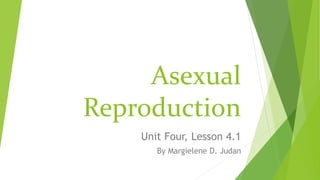
Unit 4, Lesson 4.1 - Asexual Reproduction
- 1. Asexual Reproduction Unit Four, Lesson 4.1 By Margielene D. Judan
- 2. Lesson Outline Reproduction Types of Reproduction Methods of Asexual Reproduction
- 4. Reproduction Reproduction is the creation of “new individuals” from existing individuals.
- 5. Two Types of Reproduction Sexual – involves sex cells (egg, sperm) Asexual – does not involve sex cells
- 6. Refer to p.125 In asexual reproduction, the parent cell is SINGLE AND DIVIDING. (ex. amoeba, hydra, fungi, bacteria, etc.)
- 7. Refer to p.125 In sexual reproduction, the offspring are genetically identical (exact clones) to their parents. (ex. humans, elephants, dogs, fishes, plants, etc.)
- 9. Asexual Reproduction Formation of new individuals from the cell(s) of a single parent Very common among plants, fungi, microbes, and invertebrates Advantage: organism can reproduce even without a mate or partner
- 10. Common Types of Asexual Reproduction Budding Fission Fragmentation Spore formation or sporulation Vegetative propagation Grafting Layering
- 11. 1. Budding New individual is formed by formation of a bud It new organism is attached as it grows, separating only when it is mature, which leaves a scar on the parent.
- 13. 2. Fission Body divides into two (binary) or more (multiple) pieces
- 14. 3. Fragmentation Keyword: fragment The breaking of any parts of the body into several pieces The broken parts develop into complete individuals via regeneration.
- 15. 3. Fragmentation In starfishes, they can cast a part of their body to lure and escape predators. It is called autotomy. (You can cut a starfish in half and in a year-time, you will have 2 starfish. But not all starfish can bounce easily to injury.) Stem cells are responsible for that.
- 16. 4. Spore formation or sporulation A spore contains haploid cells (n) enclosed in a thick case and held together by the sporangium. Upon maturation, the sporangium bursts and releases the spores to become new organisms. Common among fungi and simple plants (mosses and ferns)
- 17. 4. Spore formation or sporulation Spores finally become living organisms via sexual reproduction. It combines with the male sex cell forming a diploid cell (2n) n + n = 2n n= half the # of chromosomes
- 18. 5. Vegetative propagation Roots, stems and leaves are “special vegetative structures”, meaning they can reproduce clone offspring. Used mostly by gardeners and agriculturists to produce plants with desirable traits.
- 19. 5. Vegetative propagation (Cutting) Example 1: Cuttings (ex. Banana)
- 20. 5. Vegetative propagation (Grafting) Example 2: Grafting (ex. apples) 2 plants are used to develop a new plant scion – a piece of young stem or bud inserted to the root stock stock – a rooted stem which a scion is grafted
- 21. 5. Vegetative propagation (Grafting) The scion is selected for good quality of fruits, flowers, resistance to diseases, etc. The stock is selected for good quality of roots.
- 22. 5. Vegetative propagation (Layering) Example 3: Layering (ex. raspberries)
- 23. Laboratory Task 2.1: Refer to pp.146- 147. (by group) Choose only one: either product 1 or 3. For product 1, you need to produce copies for each group in both section, plus one for the teacher. The content will be included in the exam. For product 3, you need to make a presentation (ex. skit, performance, song, play, etc.) with your group. The judges are your classmates, and your score will depend on the average times 10. If your average is 9.2, then 9.2 x 10 = 92/100 = 92% This task will comprise almost half of your laboratory grade.
- 24. Laboratory Task 2.1: Refer to pp.146- 147. (by group) The performance of each group will be scheduled on different dates, to be performed at the start of the class period. (minimum of 5 minutes; maximum of 15). In the mechanics section in the rubric, instead of checking the spelling and punctuation, we will check the diction and creativity. The output is due on different dates also. In the mechanics section, the layout of the brochure is to be considered also. Only one group per day will perform.
- 25. Laboratory Task 2.1: Refer to pp.146- 147. (by group) Available dates for Agate o Sept. 8-10 (Tue to Thurs) o Sept. 14 (Mon) o Sept. 16 (Wed) Available dates for Amber o Sept. 9-11 (Wed to Fri) o Sept. 15 (Tue) o Sept. 17 (Thurs)
- 26. Sources: Science Links 7 http://leavingbio.net/vegetativepropagatio n.htm